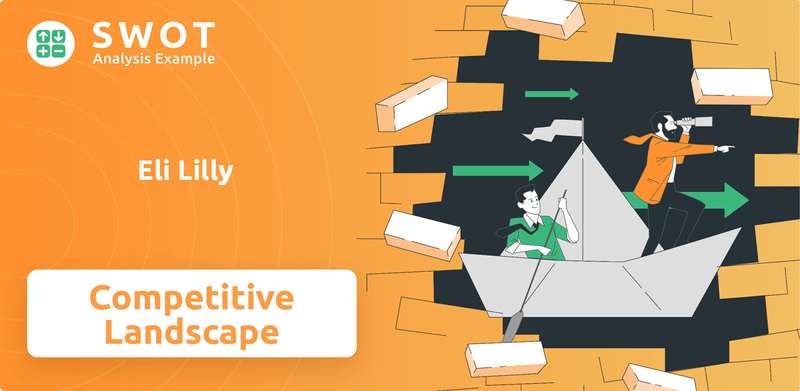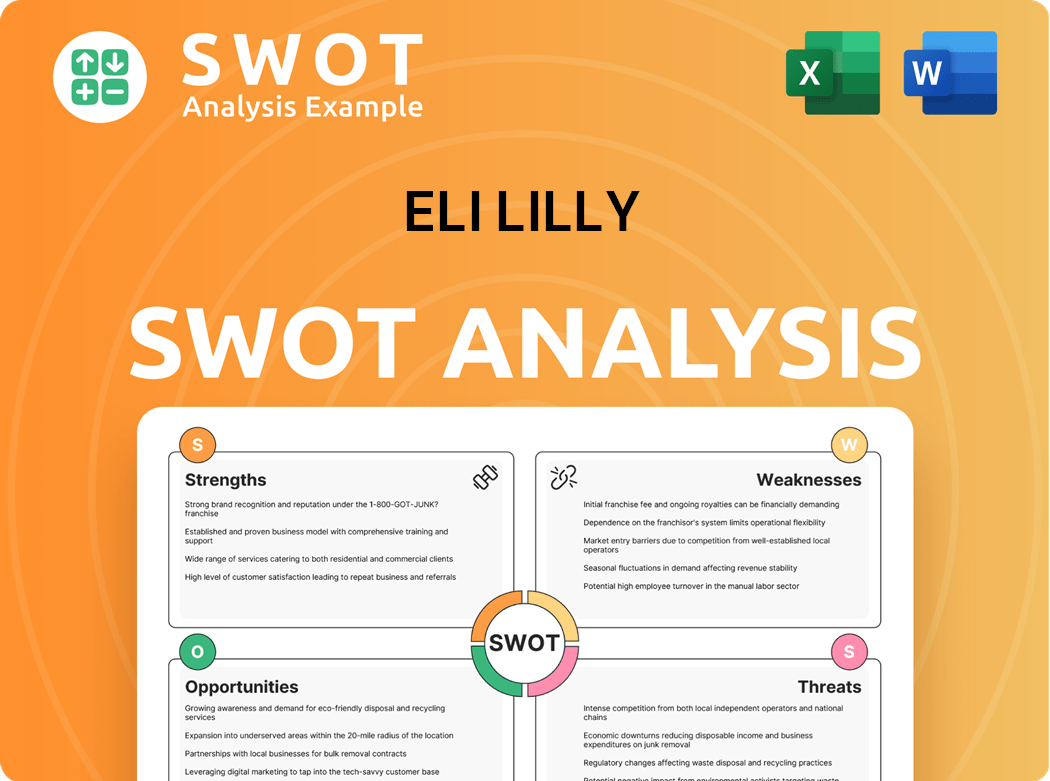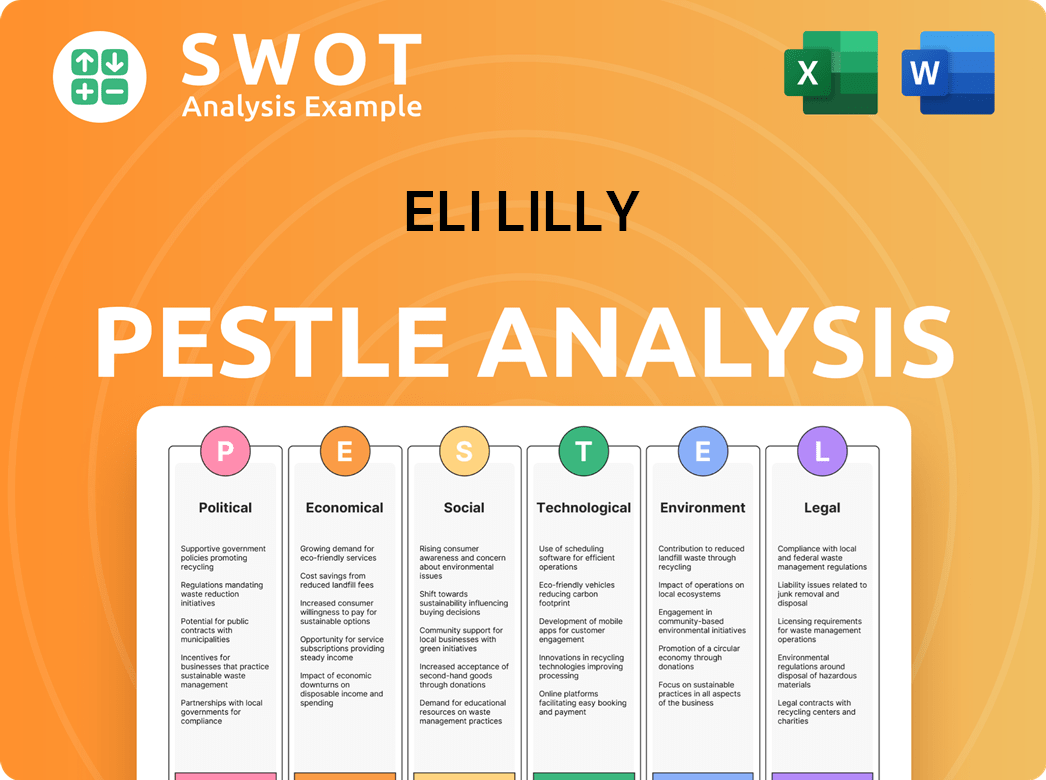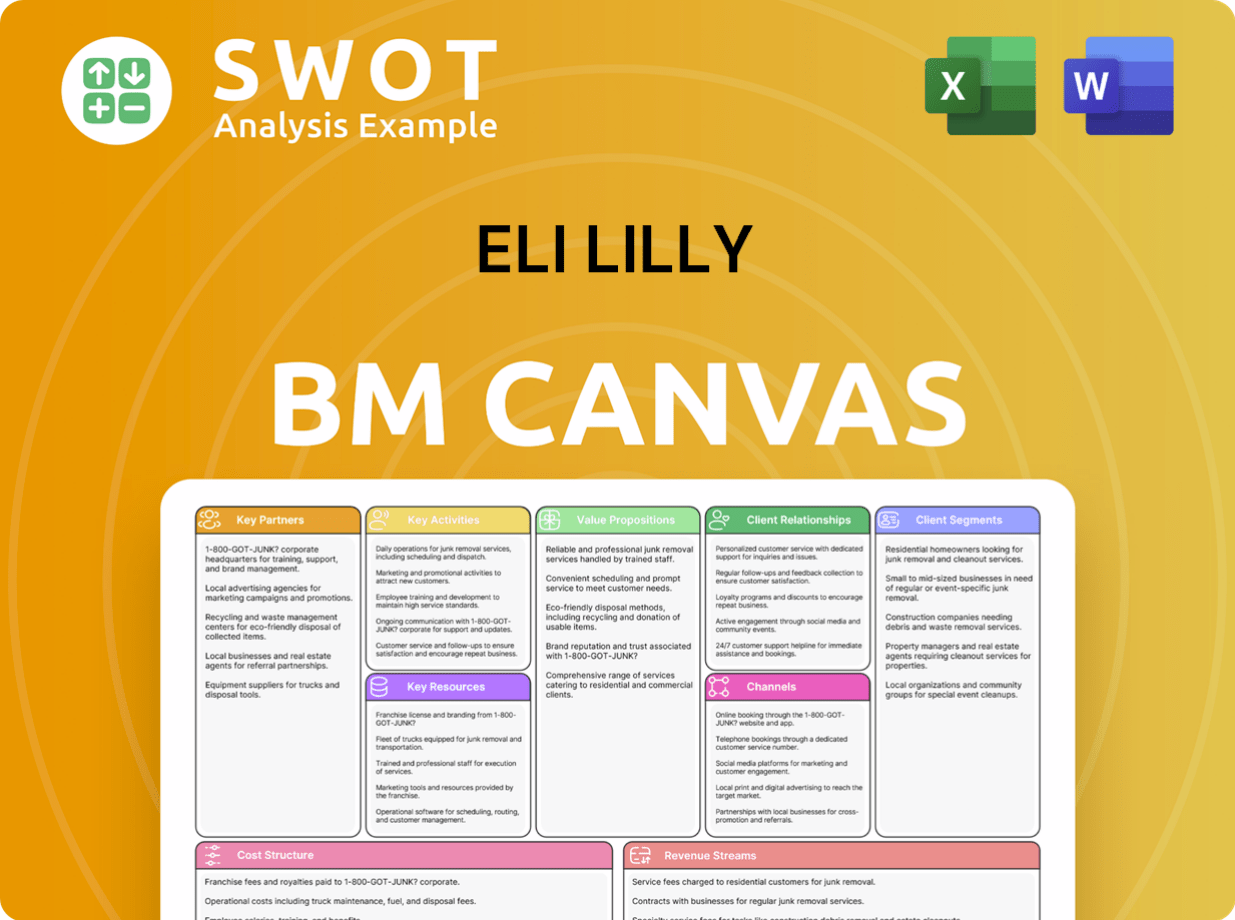Eli Lilly Bundle
Can Eli Lilly Maintain Its Dominance in the Pharmaceutical Arena?
For over a century, Eli Lilly and Company has been a titan in the pharmaceutical industry, consistently innovating and adapting to meet evolving healthcare needs. From its early days producing effective medicines to its current position as a global leader, Eli Lilly SWOT Analysis reveals a company built on a foundation of scientific rigor and a commitment to improving lives. But in the dynamic world of drug development, how does Eli Lilly navigate the ever-changing competitive landscape?

This analysis dives deep into the Eli Lilly competitive landscape, providing a comprehensive market analysis of its key rivals and exploring its competitive advantage. We will examine Eli Lilly's financial performance versus competitors, its strategic positioning in the US market and globally, and the impact of patent expirations on its portfolio. Understanding Eli Lilly's strengths and weaknesses is crucial to assessing its future outlook and navigating the challenges and opportunities within the pharmaceutical industry, particularly in areas like diabetes care and oncology.
Where Does Eli Lilly’ Stand in the Current Market?
As of May 2025, the market position of Eli Lilly and Company (addressing the Eli Lilly competitive landscape) is robust, underscored by substantial growth and strategic focus. The company's market capitalization is approximately $697.28 billion. This strong financial standing supports its ability to compete and innovate within the pharmaceutical industry.
In 2024, Eli Lilly's total revenue reached approximately $45.8 billion, a 25.98% increase from the prior year, surpassing the industry average. The company’s financial performance is further highlighted by a gross profit margin that improved to 81.31% in 2024 from 79.25% in 2023. Net income for 2024 was $10.59 billion, more than doubling the $5.24 billion recorded in 2023, indicating strong operational efficiency.
Eli Lilly's core operations are centered on drug development and commercialization, with a focus on high-growth therapeutic areas. The company leverages its research and development capabilities to create innovative medicines. Key areas include diabetes, obesity, oncology, immunology, and cardiovascular conditions.
The value proposition of Eli Lilly lies in its ability to deliver life-changing medicines. The company's products address significant unmet medical needs. This includes therapies for diabetes, obesity, and cancer. This focus drives both patient outcomes and shareholder value.
Eli Lilly's primary product lines are anchored by incretin-based therapies. The company's market share in the GLP-1 arena was 35% as of Q1 2025, compared to Novo Nordisk's 62%. Mounjaro and Zepbound (tirzepatide) are significant drivers of growth. In Q4 2024, Mounjaro generated $3.53 billion in revenue, while Zepbound sales reached $1.91 billion.
Eli Lilly operates globally, with a strong presence in the U.S., Europe, China, and Japan. The company plans to launch tirzepatide in India by 2025. In 2024, the company's return on equity was 19.02%. The current ratio of 1.27 suggests adequate liquidity.
The Eli Lilly competitors include Novo Nordisk, particularly in the GLP-1 market. Eli Lilly's competitive advantage is derived from its innovative pipeline and strong market presence in key therapeutic areas. This includes oncology (Verzenio), immunology (Taltz), and cardiovascular conditions (Jardiance, co-marketed with Boehringer Ingelheim).
- Key strengths include a robust product portfolio and strong financial performance.
- Weaknesses may include the challenges of patent expirations and intense competition in the diabetes and obesity markets.
- Opportunities exist in emerging markets like India and through strategic partnerships.
- Threats include the potential for generic competition and regulatory changes.
For more insights into the company's ownership structure and financial performance, you can refer to Owners & Shareholders of Eli Lilly. The Lilly market analysis reveals the company's strategic focus on high-growth areas. This positioning is essential for navigating the dynamic Eli Lilly competitive landscape and ensuring long-term success.
Eli Lilly SWOT Analysis
- Complete SWOT Breakdown
- Fully Customizable
- Editable in Excel & Word
- Professional Formatting
- Investor-Ready Format

Who Are the Main Competitors Challenging Eli Lilly?
The Eli Lilly competitive landscape is shaped by intense rivalry and constant innovation within the pharmaceutical industry. The company faces a dynamic market, requiring strategic adaptation to maintain and enhance its competitive advantage. Understanding the key players and their strategies is crucial for evaluating Lilly's position and future prospects.
Lilly's market analysis reveals a complex environment where success hinges on factors such as drug development, clinical trial outcomes, regulatory approvals, and effective marketing. The company's ability to navigate these challenges and capitalize on opportunities determines its financial performance and market share. The competitive strategies of Eli Lilly are critical in this environment.
Eli Lilly operates in a fiercely competitive pharmaceutical sector, facing significant direct and indirect competition from multinational giants and specialized players. Its most prominent direct rival, particularly in the rapidly expanding diabetes and obesity markets, is Novo Nordisk. Novo Nordisk, with its GLP-1 based therapies like Ozempic and Wegovy, has been a key competitor, holding a 62% market share in the GLP-1 arena as of Q1 2025, compared to Eli Lilly's 35%. The rivalry between these two companies is intense, with both investing billions to ramp up manufacturing capacity for their respective blockbuster weight-loss and diabetes drugs. The recent decision by CVS Health to prioritize Novo Nordisk's Wegovy over Zepbound in its formulary highlights the ongoing competitive battles for market share in the obesity drug market.
Novo Nordisk is a primary competitor, especially in diabetes and obesity treatments. Both companies are heavily investing in expanding production capacity.
Johnson & Johnson, AbbVie, Merck & Co., Pfizer, and Bristol-Myers Squibb compete across various therapeutic areas.
Amgen and Viking Therapeutics are developing weight-loss drugs. New oral GLP-1 agonists could disrupt the market.
Mergers and acquisitions are common, with Eli Lilly acquiring companies like DICE Therapeutics and Scorpion Therapeutics in early 2025.
Market share in the GLP-1 arena shows Novo Nordisk at 62% and Eli Lilly at 35% as of Q1 2025.
The pharmaceutical industry is constantly changing due to innovation, regulatory approvals, and marketing strategies.
Beyond this direct rivalry, Eli Lilly faces competition across its diversified portfolio from several other major pharmaceutical companies. These include Johnson & Johnson, a diversified healthcare conglomerate with a strong presence in diabetes, oncology, and immunology. AbbVie is another significant competitor, particularly in immunology, where it has established a strong market presence. Merck & Co. poses a challenge across various therapeutic areas, with a focus on oncology and a strategy of significant investments in pipeline development. Pfizer, renowned for its expansive research pipeline and strategic acquisitions in oncology, immunology, and vaccines, also presents a direct challenge to Lilly's dominance in certain segments. Bristol-Myers Squibb, with a strong focus on oncology and immunology, leverages its R&D and strategic partnerships to compete effectively. GlaxoSmithKline is also identified as a core competitor.
The competitive landscape includes established pharmaceutical giants and emerging biotech companies. Each competitor has its own strengths and focuses on specific therapeutic areas.
- Novo Nordisk: Diabetes and obesity treatments, GLP-1 therapies.
- Johnson & Johnson: Diabetes, oncology, and immunology.
- AbbVie: Immunology.
- Merck & Co.: Oncology, significant pipeline investments.
- Pfizer: Oncology, immunology, and vaccines.
- Bristol-Myers Squibb: Oncology and immunology.
- GlaxoSmithKline: Various therapeutic areas.
Emerging players are also contributing to the evolving competitive landscape. Biotech giants like Amgen and smaller biotech companies such as Viking Therapeutics are developing their own weight-loss drug candidates, with positive clinical trial data already reported. The potential entry of new oral GLP-1 agonists from companies like Pfizer could further disrupt the market, as oral tablets offer greater convenience than injectable forms. Mergers and alliances also continually reshape competitive dynamics, with companies like Eli Lilly actively acquiring firms to bolster their pipelines, such as the acquisition of DICE Therapeutics and Scorpion Therapeutics in early 2025 to enhance its oncology and rare disease pipelines.
Eli Lilly PESTLE Analysis
- Covers All 6 PESTLE Categories
- No Research Needed – Save Hours of Work
- Built by Experts, Trusted by Consultants
- Instant Download, Ready to Use
- 100% Editable, Fully Customizable

What Gives Eli Lilly a Competitive Edge Over Its Rivals?
The competitive advantages of Eli Lilly are significantly shaped by its innovative capabilities, intellectual property, and strategic operational strengths. The company has demonstrated industry-leading growth, particularly fueled by its incretin portfolio, including Mounjaro and Zepbound, which have driven substantial revenue increases. Its strong commitment to research and development (R&D) and a robust pipeline of innovative drugs further distinguish it in the pharmaceutical industry.
Eli Lilly's competitive edge is also bolstered by its proprietary technologies, intellectual property, and expertise in manufacturing. The company actively secures patents to maintain market exclusivity and has invested heavily in expanding its manufacturing capacity. Brand equity and customer loyalty, built over more than a century, contribute to its strong market standing. Strategic acquisitions and a diversified revenue stream across various therapeutic areas also play a crucial role in its sustained competitiveness.
The company's financial health, as indicated by an exceptional gross margin and net profit margin, reinforces its competitive positioning. These advantages have evolved through continuous investment and strategic foresight, enabling Eli Lilly to maintain a leadership position in a highly contested industry. To understand more about how the company plans to grow, check out the Growth Strategy of Eli Lilly.
Eli Lilly's commitment to research and development (R&D) is a core competitive advantage, with R&D spending approximately 24.7% of revenue in 2024. This sustained investment has resulted in a strong pipeline of innovative drugs, including potential game-changers like orforglipron. This focus allows the company to stay ahead in the pharmaceutical industry.
Proprietary technologies and intellectual property are critical to Eli Lilly's sustained competitiveness. The company actively secures and defends patents to maintain market exclusivity and protect its revenue streams. It has committed more than $20 billion since 2020 to build, expand, and acquire manufacturing sites in the United States and Europe.
Eli Lilly's strong financial health, indicated by an exceptional gross margin exceeding 80% and a net profit margin of 23.5% in 2024, further reinforces its competitive positioning. Strategic acquisitions, such as those to bolster its oncology and rare disease pipelines, enhance its growth strategy and potential for long-term success.
The company's diversified revenue streams across various therapeutic areas, including oncology, immunology, and neuroscience, mitigate the risk of relying on a single product. The incretin portfolio, including Mounjaro and Zepbound, has driven substantial revenue increases, with a year-over-year growth of 26% in Q1 2024.
Eli Lilly's competitive advantages stem from a combination of innovative capabilities, strategic investments, and strong financial performance. These factors enable the company to maintain its leadership position in the pharmaceutical market.
- Industry-leading growth rates, particularly driven by the incretin portfolio.
- Significant investments in research and development, resulting in a robust drug pipeline.
- Strong financial health, with high gross and net profit margins.
- Strategic acquisitions to enhance growth and diversify the product portfolio.
Eli Lilly Business Model Canvas
- Complete 9-Block Business Model Canvas
- Effortlessly Communicate Your Business Strategy
- Investor-Ready BMC Format
- 100% Editable and Customizable
- Clear and Structured Layout

What Industry Trends Are Reshaping Eli Lilly’s Competitive Landscape?
The Eli Lilly competitive landscape is currently shaped by industry-wide trends, presenting both challenges and substantial opportunities. The company faces intense competition within the pharmaceutical industry, particularly in high-growth areas like diabetes and obesity treatments. However, its strong product pipeline and strategic focus on key therapeutic areas position it favorably for future growth. This analysis examines the industry trends, future challenges, and opportunities that will likely influence Eli Lilly's competitive positioning.
The pharmaceutical industry is undergoing significant transformation, driven by technological advancements, regulatory changes, and evolving consumer preferences. Eli Lilly's market analysis indicates that its ability to adapt to these shifts will be crucial for maintaining its competitive edge. The company's financial performance and strategic decisions will be key factors in determining its success in the coming years.
Technological advancements, such as AI-powered drug discovery, are accelerating drug development. Regulatory changes, including the Inflation Reduction Act of 2022, impact drug pricing and profitability. Consumer demand for innovative treatments, especially in chronic conditions like obesity and diabetes, is rising.
Intense competition, particularly in the GLP-1 market, with rivals like Novo Nordisk. Potential pricing pressures due to regulatory changes and increased scrutiny. Supply constraints for popular products can limit market share and revenue.
Expansion into emerging markets offers significant growth potential. A robust pipeline, including anticipated data readouts for orforglipron and retatrutide, could strengthen its position. Strategic partnerships and acquisitions can diversify offerings and address unmet medical needs.
Eli Lilly anticipates revenue for 2025 to be between $58.0 billion and $61.0 billion, indicating continued growth. The company is investing in R&D and expanding manufacturing to capitalize on market opportunities. The outlook remains positive due to a strong product portfolio and strategic focus.
The competitive advantage of Eli Lilly lies in its robust product portfolio, particularly in diabetes and obesity treatments. Key Eli Lilly competitors include Novo Nordisk, with emerging players like Amgen and Viking Therapeutics. Eli Lilly's main rivals in diabetes care and obesity treatments are in a tight competition.
- R&D Investments: Eli Lilly's R&D investments are crucial for maintaining a competitive edge.
- Market Expansion: Expanding its presence in ex-US markets is a key strategy for long-term volume growth.
- Product Pipeline: The company's pipeline, including orforglipron and retatrutide, is expected to drive future growth.
- Strategic Partnerships: Acquisitions and partnerships are essential for diversifying offerings and addressing unmet medical needs.
Eli Lilly Porter's Five Forces Analysis
- Covers All 5 Competitive Forces in Detail
- Structured for Consultants, Students, and Founders
- 100% Editable in Microsoft Word & Excel
- Instant Digital Download – Use Immediately
- Compatible with Mac & PC – Fully Unlocked

Related Blogs
- What are Mission Vision & Core Values of Eli Lilly Company?
- What is Growth Strategy and Future Prospects of Eli Lilly Company?
- How Does Eli Lilly Company Work?
- What is Sales and Marketing Strategy of Eli Lilly Company?
- What is Brief History of Eli Lilly Company?
- Who Owns Eli Lilly Company?
- What is Customer Demographics and Target Market of Eli Lilly Company?
Disclaimer
All information, articles, and product details provided on this website are for general informational and educational purposes only. We do not claim any ownership over, nor do we intend to infringe upon, any trademarks, copyrights, logos, brand names, or other intellectual property mentioned or depicted on this site. Such intellectual property remains the property of its respective owners, and any references here are made solely for identification or informational purposes, without implying any affiliation, endorsement, or partnership.
We make no representations or warranties, express or implied, regarding the accuracy, completeness, or suitability of any content or products presented. Nothing on this website should be construed as legal, tax, investment, financial, medical, or other professional advice. In addition, no part of this site—including articles or product references—constitutes a solicitation, recommendation, endorsement, advertisement, or offer to buy or sell any securities, franchises, or other financial instruments, particularly in jurisdictions where such activity would be unlawful.
All content is of a general nature and may not address the specific circumstances of any individual or entity. It is not a substitute for professional advice or services. Any actions you take based on the information provided here are strictly at your own risk. You accept full responsibility for any decisions or outcomes arising from your use of this website and agree to release us from any liability in connection with your use of, or reliance upon, the content or products found herein.